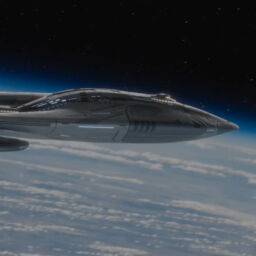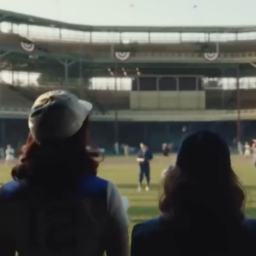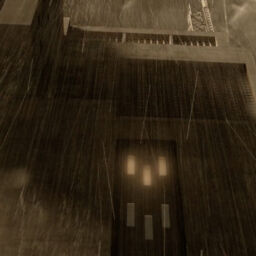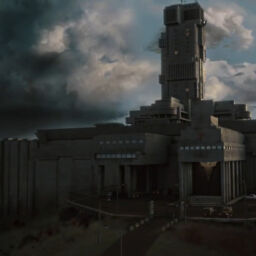With its combination of supernatural elements, strong characters, a unique visual style, and a very devoted fan base, Lucifer was an acclaimed series that CoSA VFX is proud to have worked on. In creating VFX for the show, our artists and VFX supervisors had numerous opportunities to create and explore Lucifer’s world over multiple seasons. For the show’s final season, CoSA was able to create and explore even more new elements!
We spoke with VFX Supervisor John Cherniack about that final season. Do be aware that there are Season 6 plot points being discussed, so if you haven’t watched yet, you might want to hold off on reading more. All six seasons of Lucifer are currently available on Netflix at the time of this writing.
Going into Season 6, the show introduced the character of Aurora a.k.a. “Rory,” Lucifer and Chloe Decker’s daughter from the future. For this character, CoSA VFX had to put together several new looks, including new wings that were different from the myriad of angel and devil wings we had seen before on the series.
“The unique part about Rory’s wings were that they were weaponized, so when we first read the script and read about her using them to attack, it brought a whole new sense of what we had to do to make them work,” John recalls. The team had to combine the attributes of the wings being feathers and also sharp blades at the same time, figuring out how to make them properly articulate.

Rory’s wings would have more weight to them, but the character had a celestial strength; this also changed the way they appeared to move. Lucifer writer Chris Rafferty made a concept design of what the wings could look like. We expanded on the concept with designing individual feathers first, and then populating them into a full wing to fully conceptualize the finished wing into something we haven’t seen before in the series.

The character of Rory also allowed us to create her character’s “devil face” which wasn’t quite like her father’s. “This was a fun one for us, because we took seasons’ worth of learning with Lucifer’s face and were able to start out fresh with Rory’s and do all of the things we learned along the way,” John recalls. To build the face, we first scanned the actual face of actress Brianna Hildebrand who played Rory, and every bone structure of her face had to match perfectly in order for our CG one to align seamlessly when her devil face was not fully revealed. Our CG team did several different concepts for the face and then started making a rig, which was a hybrid solution — a combination of a traditional skeleton rig assisted by blend shapes. Once we saw the final performance in the edit, we added more blend shapes for specific expressions Rory had to do with her face.
Finally, another exciting element with Rory was seeing her character teleporting away from her parents for the final time, returning to the future. When this was shot, we had a lot of interactive lighting on set to make the scene feel more alive. Dynamics Lead Yongji Chen and Lead Compositor Alessandro La Tona were able to be creative with this sequence; combining different Houdini energy renders in comp to create the distinctive teleportation look. “What the two of them came up with together was just brilliant,” John says. As she disappeared, the colors would all dissipate into particles. Even her clothes and skin color would all join into it, to make it feel like she was becoming the celestial vapor.

Season 6 had two of the show’s actors – Kevin Alejandro (Dan) and DB Woodside (Amenadiel) directing, which gave Cherniack the opportunity to work with them directly on various shots and sequences.

“Working with Kevin and Chris Rafferty on the Dan ghost effect was a lot of fun,” John says, referring to an episode where Detective Dan’s ghost ends up in the body of Vincent Le Mec. “It was fun because the two of them are wrestling for a gun, but the rules of ‘ghost time’ for the show were that Dan can’t touch anything,” he explains. The sequence required some advanced planning, green screens, and match moving in CG so that everything feels like it’s in the right world space.
DB Woodside also directed an episode in the final season, and during filming, he approached John with the idea of turning in the air with his wings coming out. “We shot him running up to the edge of the roof jumping off, and then we also shot him on a turntable on a green screen doing his heroic spin, and added his wings unfurling into it. DB came up with this dynamic idea for the sequence early on in the planning for the episode. We loved where he was going with it and worked with the camera department and grips to make his vision come alive,” John says.
Fights using digital doubles, devil faces, but let’s not forget Lucifer himself. Another Season 6 highlight for the CoSA VFX team happened in the finale, where Lucifer takes flight in a shipyard. The whole shot was about two and a half minutes long. “This long shot took a day to rehearse and an entire day to shoot. We used a Titan motion control robot on 100 feet of track that could replicate the same camera move over and over again. We shot it in sections and then stitched it all together in the end,” Cherniack recalls. “Even Tom’s wire work was all pre-programmed so he could take off and land in the same place each jump and be in sync with the camera. Once in the air, Tom is very comfortable on wires and always gives such a good performance for us to add visual effects to.”
Lastly, Heaven was introduced as a new fantasy environment in the show’s final season. It was something that the production designer Alex Hajdu had thought up and designed with the showrunners. The throne room was one of the largest sets they had on this. It took up over an entire stage. As far as Heaven itself, it was very influenced by nature and organic-like Gothic architecture styles. The establishing scene was created as a large matte painting, with waterfalls and other animated elements on the floating island to give it life surrounded by sea of dynamic clouds.

The opportunity to work on a show like Lucifer is one that will not be forgotten by us here at CoSA VFX, and we look forward to working with the Lucifer team again someday. As previously mentioned, the entire journey can currently be binged on Netflix, and we thank all of the artists, crew, supervisors, and collaborators who worked with us on making devils and angels fly.
Please consider Lucifer for Outstanding Visual Effects in a Photoreal Episode.
ABOUT CoSA VFX
Founded in 2009, CoSA VFX has grown from a small boutique into a thriving visual effects studio with offices in Los Angeles, Atlanta, and Vancouver. The CoSA VFX team has received Emmy nominations and wins for their work on TV series including Marvel’s Agents of S.H.I.E.L.D., Gotham and Westworld. The studio’s recent projects include Lucifer for Netflix and Syfy’s Resident Alien. CoSA VFX provides visual effects for multiple studios, networks and streaming television services.
FOLLOW CoSA VFX
http://cosavfx.com
http://facebook.com/cosavfx
http://twitter.com/cosavfx
https://www.linkedin.com/company/cosa-vfx/
MEDIA CONTACT
Craig Byrne
Publicist/Social Media Manager
Craig.Byrne@cosavfx.com
















